|
|
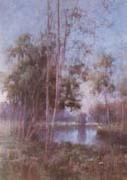 |
Jane Sutherland
|
|
Australian, 1853-1928, Australian painter. She was the eldest daughter of George Sutherland (1829-85), a carver, music teacher and artist who moved with his family to Australia from Glasgow in 1864, settling in Melbourne in 1870. She attended the National Gallery School from 1871 to 1885 and was awarded the R. Wallen Prize in 1883. From mid-1888 she occupied a studio with Clara Southern and gave art lessons in Grosvenor Chambers, Collins Street |
|
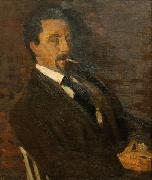 |
Janis Rozentals
|
|
(March 18, 1866, Bebri Farmstead, Saldus parish, Courland Governorate - December 26, 1916) was a Latvian painter.
Rozentels received the basic education at H.Krause's Elementary School in Saldus and Kuldega District School. At the age of fifteen the boy left for Riga and consistently tried to realize his dream about art, later entering St.Petersburg Academy of Art. During study vacations the developing artist visited his native land to relax from the hectic rhythm of the large city, paint motifs from nature and commissioned portraits. For his diploma work he took as models the young educated Latvians and local farmers. A little later the artist decided to settle in Saldus as he wanted to live among his people and create art appropriate to its aspirations and feelings. In spring 1899 Rozentels bought a building plot at the Striķu street and set up a studio, but his intents were not well received in the provincial town and he moved to Riga two years later. Now a memorial museum is arranged in the building designed by the artist. Fateful turn in life of the painter happened in November, 1902, when Janis Rozentels got acquainted with Elli Forsell(1871 - 1943), a Finnish singer, in Riga. On February 20, 1903, they got married. They found home in a flat- studio, in Alberta street, in Riga. they had three children - Laila, Irja and Miķelis. World War I interrupted the family's life in Riga and in 1915 they relocated to Finland. He died suddenly on December 26, 1916 and was buried in Helsinki, though later was reburied in his homeland. Today, the Janis Rozentels Art Highschool in Riga is named after him, and has had his name since 1946. |
|
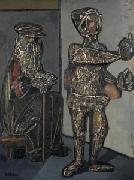 |
Jankel Adler
|
|
(July 26, 1895 ?C April 25, 1949) was a Polish painter and printmaker.
He was born as the seventh of ten children in Tuszyn, a suburb of Ł??dź. In 1912 he began training as an engraver with his uncle in Belgrade. He moved in 1914 to Germany where he lived for a time with his sister in Barmen. There he studied at the college of arts and crafts with professor Gustav Wiethecher.
From 1918-1919 he went back to Ł??dź, where he was joint founder of a group of avant-garde artists. In 1920 he returned briefly to Berlin; in 1921 he returned to Barmen, and in 1922 he moved to Desseldorf. There he became a teacher at the Academy of Arts, and became acquainted with Paul Klee, who influenced his work. A painting by Adler received a gold medal at the exhibition German art Desseldorf in 1928.
In 1929 and 1930 he went on study trips in Mallorca and other places in Spain. During the election campaign of July 1932 he published with a group of leftist artists and intellectuals an urgent appeal against the policy of the National Socialists and for communism. As a modern artist, and especially as a Jew, he faced persecution under Hitler's regime which took power in 1933. |
|
 |
Janos Donat
|
|
1744-1830
Hungarian
Janos Donat Location
Donat was born in Klosterneuzell in 1744 and learned painting at M. Meytens, V. Fischer and Sambach in Vienna where he lived for some time and later Prague. In Vienna he became interested in painting portraits. After moving to Pest in 1810 he painted some of his most noted classicist portraits such as Ferenc Kazinczy in 1812 and Benedek Virag in 1815.
He was also noted for his compositions such as Resting Venus, Orfeus and Euridike, and Proserpina which were paintings of mythological creatures. |
|
 |
Janssens van Ceulen
|
|
Cornelis Janssens van Ceulen (also Cornelius Jonson van Ceulen, Cornelius Johnson, Cornelis Jansz. van Ceulen and many other variants) (bapt. October 14, 1593, London - bur. August 5, 1661, Utrecht) was an English painter of portraits of Dutch or Flemish parentage. He has been described as "one of the most gifted and prolific portrait painters practising in England during the 1620s and 1630s".
|
|
 |
JANSSENS, Abraham
|
|
Flemish painter (b. 1575, Antwerpen, d. 1632, Antwerpen).
Flemish painter. He painted historical, religious and mythological subjects, often on a large scale, derived principally from antique sculpture and the art of Michelangelo and Raphael and, to a lesser degree, from certain contemporaries, including the Dutch late Mannerists and the Bolognese school. He was highly esteemed in Antwerp but suffered, then and subsequently, from the inevitable comparison with his contemporary and formidable rival Rubens |
|
 |
JANSSENS, Jan
|
|
Flemish painter (b. 1590, Ghent, d. after 1650, ?)
Flemish painter, active also in Italy. He became a master in the painters' guild of his native Ghent in 1621, but before that he spent considerable time in Italy, particularly Rome, where he is documented in 1619 and 1620. There he became associated with the international Caravaggesque movement and was especially influenced by the paintings of the Utrecht Caravaggisti, such as Gerrit van Honthorst and Dirck van Baburen. Immediately after his return to Ghent, Janssens introduced the style of Caravaggio there. His altarpieces and other painted compositions with mercilessly realistic representations of biblical and hagiographic themes were particularly sought after for churches in and around Ghent. In these works Janssens achieved a high emotional impact by modelling the figures and objects with a strong light from a hidden source. Typical examples are the Christ Crowned with Thorns (1627; Ghent, St Peter) and the Martyrdom of St Barbara (Ghent, St Michael). Such paintings met the demand that sprang from the Counter-Reformation for strongly emotional representations of religious themes. Janssens also occasionally worked for a public that was more international in outlook, as is demonstrated by his Caritas Romana |
|
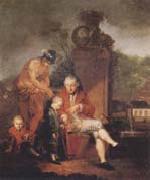 |
Januarius Zick
|
|
German,1730-1797
was a painter and architect. He is considered to be the one of the main masters of the Late-Baroque. Januarius Zick was born in Munich and began to learn his trade from his father, Johannes Zick, a renowned painter himself, to whom he was apprenticed in order to learn how to paint frescoes. In 1744, when Januarius Zick was fourteen years old, his brother, three years his junior, fell to his death from a scaffolding in Weingarten. From 1745 to 1748, Januarius Zick was apprenticed as a bricklayer to Jakob Emele in Schussenried. Having finished his apprenticeship, he worked, together with his father, at the residence of the Prince-Bishop of Wurzburg and then, until the mid-1750s, at the residence of the Prince-Bishop of Speyer in Bruchsal. In 1756, Januarius Zick went to Paris to further his education. There, he came into contact with artists and art connoiseurs from Rome, Basel and Augsburg, who broadened his horizon concerning his art and had a considerable influence on him. After having furnished Castle Engers near Neuwied with frescoes in 1760, he was appointed court painter to the Prince-Elector of Trier, the archbishop of Trier. He married in Ehrenbreitstein and settled there. After 1774, he also designed intarsia paintings for cabinet maker David Roentgen. From the late 1770s on, Januarius Zick was very active in Upper Swabia, furnishing a number of monastery churches and parish churches with frescoes and altarpieces. |
|
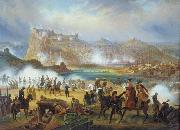 |
January Suchodolski
|
|
(September 19, 1797 - March 20, 1875) was a Polish painter and Army officer.
Suchodolski was born in Grodno and was the brother of Rajnold Suchodolski.
From 1832 to 1837 Suchodolski studied in Rome, where he was a pupil of Horace Vernet. Suchodolski became known for his history and battle paintings.
He died in Bojmie (near Siedlce).
|
|
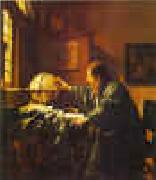 |
JanVermeer
|
|
1632-1675
Johannes (or Jan) Vermeer is now recognized as one of the great Dutch painters, but while he was alive he could barely make ends meet, and his artistic achievement was almost entirely ignored for 200 years after his death. Little is known about his personal life, other than he died poor and young and left behind a wife and eleven children. Vermeer is admired for his realistic style, his subtle use of color and light and his unusual and inventive brush technique, but fewer than forty of his paintings exist. His most famous works include domestic scenes such as Girl With a Peal Earring (1665) and The Music Lesson (1662-65), and tranquil landscapes such as The Little Street (1657-58) and View of Delft (1659-60).
Although his actual birth and death dates are unknown, Vermeer was baptized 31 October 1632 and buried 15 December 1675... During his career he used the names Johannes van der Meer, Johannes Vermeer and Jan Vermeer... He was played by actor Colin Firth in the 2003 film Girl With A Pearl Earring, which also starred Scarlett Johansson as the girl.
|
|
|
|
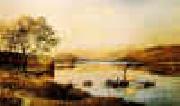 |
Jasper Cropsey
|
|
American Hudson River School Painter, 1823-1900
Jasper Francis Cropsey (February 18, 1823 - April 23, 1900) was an important American landscape artist of the Hudson River School.
Cropsey was born on his father Jacob Rezeau Cropsey's farm in Rossville on Staten Island, New York, the oldest of eight children. As a young boy, Cropsey had recurring periods of poor health. While absent from school, Cropsey taught himself to draw. His early drawings included architectural sketches and landscapes drawn on notepads and in the margins of his schoolbooks. After studying architecture for five years, he turned his attention to landscape painting, under the instruction of Edward Maury. He visited England, France, Switzerland, and Italy in 1847, went abroad again in 1855, and resided seven years in London, sending his pictures to the Royal Academy and to the International exhibition of 1862.
After his return home in 1863, he opened a studio in New York, where he resided until 1885, when he removed to Hastings-on-Hudson.
Trained as an architect, he set up his own office in 1843. Cropsey studied watercolor and life drawing at the National Academy of Design and first exhibited there in 1844. A year later he was elected an associate member and turned exclusively to landscape painting in the 1840s, shortly after he was featured in an exhibition entitled "Italian Compositions."
Cropsey married Maria Cooley in May 1847, traveled in Europe from 1847-1849, was elected a full member of the Academy in 1851, and lived in England 1856-1863. During this time he specialized in autumnal landscape paintings of the northeastern United States, often idealized and with vivid colors. One such painting is "The Valley of the Wyoming" set in eastern Pennsylvania. The name of this valley was given to the western state of Wyoming.
He co-founded, with ten fellow artists, the American Society of Painters in Water Colors in 1866. |
|
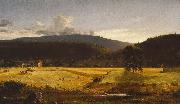 |
Jasper Francis Cropsey
|
|
(February 18, 1823 - April 23, 1900) was an important American landscape artist of the Hudson River School.
Cropsey was born on his father Jacob Rezeau Cropsey's farm in Rossville on Staten Island, New York, the oldest of eight children. As a young boy, Cropsey had recurring periods of poor health. While absent from school, Cropsey taught himself to draw. His early drawings included architectural sketches and landscapes drawn on notepads and in the margins of his schoolbooks.
Trained as an architect, he set up his own office in 1843. Cropsey studied watercolor and life drawing at the National Academy of Design under the instruction of Edward Maury and first exhibited there in 1844. A year later he was elected an associate member and turned exclusively to landscape painting; shortly after he was featured in an exhibition entitled "Italian Compositions."
Cropsey married Maria Cooley in May 1847, traveled in Europe from 1847-1849, visiting England, France, Switzerland, and Italy. He was elected a full member of the Academy in 1851. Cropsey was a personal friend of Henry Tappan, the president of the University of Michigan from 1852 to 1863. At Tappan's invitation, he traveled to Ann Arbor in 1855 and produced two paintings, one of the Detroit Observatory, and a landscape of the campus. He went abroad again in 1855, and resided seven years in London, sending his pictures to the Royal Academy and to the International exhibition of 1862.
Returning home, he opened a studio in New York and specialized in autumnal landscape paintings of the northeastern United States, often idealized and with vivid colors. Cropsey co-founded, with ten fellow artists, the American Society of Painters in Water Colors in 1866. He resided in the City until 1885, when he removed to Hastings-on-Hudson.
The monument of Jasper Francis Cropsey in Sleepy Hollow CemeteryCropsey's home and studio, Ever Rest, in Hastings-on-Hudson, New York as well as the largest permanent collection of Cropsey's work are open for tours by the Newington-Cropsey Foundation.
Jasper Cropsey died in anonymity but was rediscovered by galleries and collectors in the 1960s. Today, Cropsey's paintings are found in most major American museums, including the National Gallery of Art, the Metropolitan Museum of Art, the Los Angeles County Museum of Art, the Detroit Institute of Arts, the Timken Museum of Art in San Diego, the Honolulu Academy of Arts, the Fine Arts Museums of San Francisco, the Denver Art Museum, and the Museum of Fine Arts, Boston. Works by Cropsey also hang in the White House. |
|
|
|
|
|
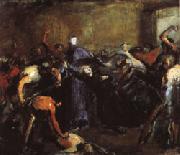 |
Jean - Baptiste Carpeaux
|
|
French Realist Sculptor, 1827-1875.
French Realist Sculptor, 1827-1875.French sculptor, painter, draughtsman and etcher. He was one of the leading sculptors of the Second Empire (1852-70) in France. |
|
|
|
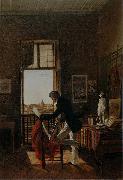 |
Jean Alaux
|
|
(1785 - 2 March 1864) was a French history painter and Director of the French Academy in Rome from 1846-52.
Alaux was born in Bordeaux, the son of a painter, and the second of four brothers who were all themselves painters. he received his first lessons in art from his father, but went on to formal training with Pierre Lacour, then Pierre-Narcisse Guerin. He was admitted to the École des Beaux-Arts in Paris in 1807. From 1808 he entered works for the Prix de Rome but his energies were diverted when his elder brother, Jean-Francois Alaux (1783-1858), asked him to help with a large "neorama" (a type of Panorama) he was working on. Jean eventually won the Prix de Rome's first prize in 1815, with a work entitled "Briseis weeping over the body of Patroclus", a scene inspired by The Iliad of Homer. He subsequently became a pensionnaire at the French Academy in Rome from 1816 to 1820 (later becoming its director). |
|
 |
Jean antoine Watteau
|
|
French Rococo Era Painter, 1684-1721
He is best known for his invention of a new genre, the f?te galante, a small easel painting in which elegant people are depicted in conversation or music-making in a secluded parkland setting (see under F?TE CHAMP?TRE). His particular originality lies in the generally restrained nature of the amorous exchanges of his characters, which are conveyed as much by glance as by gesture, and in his mingling of figures in contemporary dress with others in theatrical costume |
|
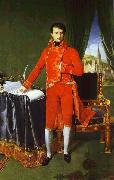 |
Jean Auguste Dominique Ingres
|
|
J. A. D. Ingres (1780-1867)
was born in Montauban on August 29, 1780, the son of an unsuccessful sculptor and painter. French painter. He was the last grand champion of the French classical tradition of history painting. He was traditionally presented as the opposing force to Delacroix in the early 19th-century confrontation of Neo-classicism and Romanticism, but subsequent assessment has shown the degree to which Ingres, like Neo-classicism, is a manifestation of the Romantic spirit permeating the age. The chronology of Ingres's work is complicated by his obsessive perfectionism, which resulted in multiple versions of a subject and revisions of the original. For this reason, all works cited in this article are identified by catalogue. |
|
 |
Jean Baptiste Camille Corot
|
|
1796-1875
Corot Locations
French painter, draughtsman and printmaker.
After a classical education at the College de Rouen, where he did not distinguish himself, and an unsuccessful apprenticeship with two drapers, Corot was allowed to devote himself to painting at the age of 26. He was given some money that had been intended for his sister, who had died in 1821, and this, together with what we must assume was his family continued generosity, freed him from financial worries and from having to sell his paintings to earn a living. Corot chose to follow a modified academic course of training. He did not enrol in the Ecole des Beaux-Arts but studied instead with Achille Etna Michallon and, after Michallon death in 1822, with Jean-Victor Bertin. Both had been pupils of Pierre-Henri Valenciennes, and, although in later years Corot denied that he had learnt anything of value from his teachers, his career as a whole shows his attachment to the principles of historic landscape painting which they professed. |
|
|
|
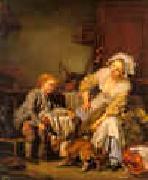 |
Jean Baptiste Greuze
|
|
1725-1805
French
Jean Baptiste Greuze Galleries
French painter and draughtsman. He was named an associate member of the Academie Royale de Peinture et de Sculpture, Paris, in 1755 on the strength of a group of paintings that included genre scenes, portraits and studies of expressive heads (t?tes d'expression). These remained the essential subjects of his art for the next 50 years, except for a brief, concentrated and unsuccessful experiment with history painting in the late 1760s, which was to affect his later genre painting deeply. Though his art has often been compared with that of Jean-Simeon Chardin in particular and interpreted within the context of NEO-CLASSICISM in general, it stands so strikingly apart from the currents of its time that Greuze's accomplishments are best described, as they often were by the artist's contemporaries, as unique. He was greatly admired by connoisseurs, critics and the general public throughout most of his life. His pictures were in the collections of such noted connoisseurs as Ange-Laurent de La Live de Jully, Claude-Henri Watelet and Etienne-Francois, Duc de Choiseul. For a long period he was in particular favour with the critic Denis Diderot, who wrote about him in the Salon reviews that he published in Melchior Grimm's privately circulated Correspondance litteraire. His reputation declined towards the end of his life and through the early part of the 19th century, to be revived after 1850, when 18th-century painting returned to favour, by such critics as Th?ophile Thore, Arsene Houssaye and, most notably, Edmond and Jules de Goncourt in their book L'Art du dix-huiti?me siecle. By the end of the century Greuze's work, especially his many variations on the Head of a Girl, fetched record prices, and his Broken Pitcher (Paris, Louvre) was one of the most popular paintings in the Louvre. The advent of modernism in the early decades of the 20th century totally obliterated Greuze's reputation. It was only in the 1970s, with Brookner's monograph, Munhall's first comprehensive exhibition of the artist's work, increased sale prices, important museum acquisitions and fresh analyses of his art by young historians, that Greuze began to regain the important place that he merits in the history of French art of the 18th century. |
|
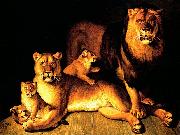 |
Jean Baptiste Huet
|
|
(Paris, 15 October 1745-Paris, 27 January 1811) was a French painter, engraver and designer associated with pastoral and genre scenes of animals in the Rococo manner, influenced by François Boucher.
Born into a family of artistse his uncle was Christophe Huet, his father Nicolas Huetehe apprenticed with the animal painter Charles Dagomer, a member of the painters' guild, the Academie de Saint-Luc, Paris, who was working in the 1760s. Huet's interest in printmaking and his acquaintance with Gilles Demarteau, who later engraved many of his compositions, both date from this period. About 1764 Huet entered the studio of Jean-Baptiste Le Prince, where he further developed his printmaking skills, largely reproducing his own paintings, a method of publishing them with some profit.
In 1768 he was approved by the Academie Royale, and 29 July 1769 he was received (reçu) in the minor category (petite maniere) of painter of animals and was well received in the public reviews when he began to exhibit at the Paris Salon that same year, with a Dog Attacking Geese, now at the Louvre. He continued to exhibit annually until 1789, through his attempts at the grand manner of history painting, considered the noblest genre, were not met with approval. |
|
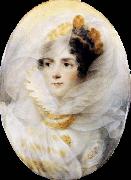 |
Jean Baptiste Isabey
|
|
French Painter, 1767-1855, Painter, draughtsman and printmaker. He trained in Nancy with Jean Girardet (d 1778) and then with Jean-Baptiste-Charles Claudot (1733-1805), master of the miniaturist Jean-Baptiste Augustin. In 1785 he went to Paris, where he began by painting snuff-boxes. In 1786 he received lessons from the painter Francois Dumont, who had also studied with Girardet in Nancy, before entering the studio of David. Although he had received aristocratic commissions before the Revolution to paint portrait miniatures of the Duc d'Angouleme and Duc de Berry and through them of Marie-Antoinette, he did not suffer in the political upheavals that followed. He executed 228 portraits of deputies for a work on the Assemblee Legislative and from 1793 exhibited miniatures and drawings in the Salon. Success came to him in 1794 with two drawings in the 'maniere noire', The Departure and The Return. This type of drawing, using pencil and the stump to simulate engraving, was very fashionable in the last years of the 18th century and reached its peak with Isabey's The Boat |
|
 |
Jean Baptiste Oudry
|
|
French Baroque Era Painter, 1686-1755
French painter. He was the principal animal painter and one of the foremost decorative painters during the first half of Louis XVs reign. After initial training as a portrait painter, he concentrated on still-lifes; by the 1720s he had also begun to establish himself as a specialist in hunting scenes, game-pieces and portraits of animals. He ran an active workshop, often keeping his best originals for years and selling copies and (more or less autograph) variants. In the 1730s he was most active as a tapestry designer, making numerous designs for the royal tapestry works of Beauvais and the Gobelins, and he continued to produce his brilliantly painted hunts, still-lifes and studies of animals and birds to the end of his career. |
|
 |
Jean Baptiste Simeon Chardin
|
|
1699-1779
French
Jean Baptiste Simeon Chardin Locations
Chardin was born in Paris, the son of a cabinetmaker, and rarely left the city. He lived on the Left Bank near Saint-Sulpice until 1757, when Louis XV granted him a studio and living quarters in the Louvre.
Chardin entered into a marriage contract with Marguerite Saintard in 1723, whom he did not marry until 1731. He served apprenticeships with the history painters Pierre-Jacques Cazes and Noël-Nicholas Coypel, and in 1724 became a master in the Acad??mie de Saint-Luc.
Upon presentation of The Ray in 1728, he was admitted to the Acad??mie Royale de Peinture et de Sculpture. The following year he ceded his position in the Acad??mie de Saint-Luc. In November of 1731 his son Jean-Pierre was baptized, and a daughter, Marguerite-Agn??s, was baptized in 1733. In 1735 his wife Marguerite died, and within two years Marguerite-Agn??s had died as well.
The Ray, 1728, Mus??e du Louvre, Paris.Beginning in 1737 Chardin exhibited regularly at the Salon. He would prove to be a dedicated academician, regularly attending meetings for fifty years, and functioning successively as counsellor, treasurer, and secretary, overseeing in 1761 the installation of Salon exhibitions.
In 1744 he entered his second marriage, this time to Françoise-Marguerite Pouget. The following year a daughter, Ang??lique-Françoise, was born, but she died in 1746.
In 1752 Chardin was granted a pension of 500 livres by Louis XV. At the Salon of 1759 he exhibited nine paintings; it was the first Salon to be commented upon by Denis Diderot, who would prove to be a great admirer and public champion of Chardin work. Beginning in 1761, his responsibilities on behalf of the Salon, simultaneously arranging the exhibitions and acting as treasurer, resulted in a diminution of productivity in painting, and the showing of replicas of previous works. In 1763 his services to the Acad??mie were acknowledged with an extra 200 livres in pension. In 1765 he was unanimously elected associate member of the Acad??mie des Sciences, Belles-Lettres et Arts of Rouen, but there is no evidence that he left Paris to accept the honor.[8] By 1770 Chardin was the Premiere peintre du roi, and his pension of 1,400 livres was the highest in the Academy.
In 1772 Chardin son, also a painter, drowned in Venice, a probable suicide. The artist last known oil painting was dated 1776; his final Salon participation was in 1779, and featured several pastel studies. Gravely ill by November of that year, he died in Paris on December 6, at the age of 80. |
|
 |
Jean Baptiste van Loo
|
|
Flemish Painter, 1684-1745
was a French subject and portrait painter. He was born in Aix-en-Provence, and was instructed in art by his father Louis-Abraham van Loo, son of Jacob van Loo. Having at an early age executed several pictures for the decoration of the church and public buildings at Aix, he was employed on similar work at Toulon, which he was obliged to leave during the siege of 1707. He was patronized by the prince of Carignan, who sent him to Rome, where he studied under Benedetto Luti. Here he was much employed on church pictures, and in particular executed a greatly praised Scourging of Christ for St Maria in Monticelli. At Turin he painted Charles Emmanuel II, Duke of Savoy and several members of his court. Then, moving to Paris, where he was elected a member of the Acad??mie Royale de Peinture et de Sculpture, he executed various altar-pieces and restored the works of Francesco Primaticcio at Fontainebleau. In 1737 he went to England, where he attracted attention by his portrait of Colley Cibber and of Owen McSwiny, the theatrical manager; the latter, like many other of van Loo's works, was engraved in mezzotint by John Faber Junior. He also painted Sir Robert Walpole, whose portrait by van Loo in his robes as chancellor of the exchequer is in the National Portrait Gallery, London, and the prince and princess of Wales. He did not, however, practise long in England, for his health failing he retired to Paris in 1742, and afterwards to Aix, where he died on 19 December 1745. |
|
|
|
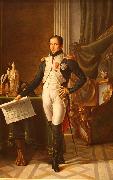 |
Jean Baptiste Wicar
|
|
Jean-Baptiste Wicar (22 January 1762, Lille - 27 February 1834, Rome) was a French Neoclassical painter and art collector.
The son of a carpenter, Wicar studied drawing at the free school in Lille before further honing his talents in the studio of David. The drawings Wicar created of Tableaux, statues, bas-reliefs et camees de la Galerie de Florence et du palais Pitti (Paintings, statues, bas-reliefs and cameos in the Gallery of Florence and the Pitti Palace) were published in Paris in 4 volumes at the Lacombe publishing house from 1789 to 1807.
Wicar headed the commission set up by Napoleon I of France to loot artworks from the Austrian Netherlands to enrich museums in France - an initial convoy left Antwerp on 11 August 1794, notably with paintings by Rubens, for the Louvre. Abbeys and castles were systematically emptied of their contents, furniture and works of art. Wicar was also a member of the commission des sciences et des arts on the Italian campaign, in the entourage of Bonaparte. This commission was charged with seizing artworks that could enrich French national museum collections. He finally permanently settled in Rome in 1800 and became a portraitist of European renown.
On his death in Rome, Wicar left the major collection of 1,300 drawings he had accumulated over his lifetime to the Societe des Sciences, de leAgriculture et des Arts de Lille. Mostly from the Italian school, but also in some small measure from the northern schools, it held drawings by artists like Raphael, Albrecht Derer, Lucas Cranach, Nicolas Poussin and Jacques-Louis David. |
|
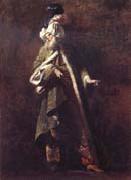 |
Jean Barbault
|
|
French Painter, 1718-1762, French painter and engraver. A pupil in Paris of Jean Restout II, in 1745 he failed to win the Prix de Rome and at his own expense went to Rome early in 1747. The following year, by which time he was a member of the circle of Paolo Anesi, Philothee-Francois Duflos, Jean-Laurent Legeay and Giovanni Battista Piranesi, Barbault made engravings for the Varie vedute di Roma antica e moderna published in Rome. As a painter he was encouraged by Jean-Francois de Troy, director of the Academie de France, who commissioned from him 20 small pictures representing characters from the Turkish masquerade organized by the pensionnaires for the carnival of 1748, of which 11 survive (Beauvais, Mus. Dept. Oise; Narbonne, Mus. A. & Hist.; Paris, Louvre (see fig.); Venice, Col. Cini; and elsewhere). When, by special favour, he became a pensionnaire at the Acad?mie (1749-53), he made a copy (Lille, Mus. B.-A., destr. 1916) for Louis XIV of Luca Penni's fresco the Baptism of Constantine in the Vatican Stanze (it was then attributed to Raphael). While travelling in Rome, Abel-Fran?ois Poisson de Vandieres, Marquis de Marigny, commissioned a series of Italian Costumes, of which some of the originals or replicas remain (Castres, Mus. Goya; Dijon, Mus. B.-A.; Orleans, Mus. B.-A.; Paris, Louvre). In 1751 Barbault depicted the planned procession of the pensionnaires for the carnival in a frieze-like painting (380*3920 mm), the Masquerade of the Four Corners of the World (Besaneon, Mus. B.-A. & Arch?ol.). Many of Barbault's idealized Roman landscapes date from this period (examples Angers, Mus. B.-A.; Baltimore, MD, Walters A.G.; Madrid, Mus. Cerralbo; Notre Dame, IN, Snite Mus. A.; and elsewhere), but above all he wanted to be a painter in the grand manner, painting St Francois de Sales Placing Jeanne de Chantal under the Protection of St Vincent de Paul (Rome, SS Giovanni e Paolo) for the beatification of Ste Jeanne de Chantal in 1751. |
|
 |
Jean Beraud
|
|
1848-1935
French
Jean Beraud Galleries
Berauds father (also called Jean) was a sculptor and was likely working on the site of St. Isaacs Cathedral at the time of his sons birth. Berauds mother was one Genevieve Eugenie Jacquin; following the death of Beraudes father the family moved to Paris. B??raud was in the process of being educated as a lawyer until the occupation of Paris during the Franco-Prussian war in 1870.
Beraud became a student of Leon Bonnat, and exhibited his paintings at the Salon for the first time in 1872, however he only gained recognition in 1876, with his On the Way Back from the Funeral. He exhibited with the Society of French Watercolorists at the 1889 Worldes Fair in Paris. He painted many scenes of Parisian daily life during the Belle epoque, in a style that stands somewhere between the academic art of the Salon and that of the Impressionists. He received the Legion d honneur in 1894.
Berauds paintings often included truth based humour and mockery of late 19th century Parisian life. Along with frequent appearances of biblical characters in then contemporary situations. Paintings such as Mary Magdalene in the House of the Pharisees aroused controversy when exhibited because of these themes.
Towards the end of the 19th century Beraud dedicated less time to his own painting, but worked in numerous exhibition committees including the Salon de la Societe Nationale.
Beraud never married and has no children, he is buried in Montparnasse Cemetery beside his mother. |
|
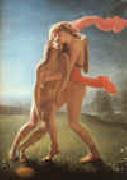 |
Jean Broc
|
|
1771-1850 French
French painter and designer. He came from a family of shopkeepers and tailors and he served in the Republican army during the wars of the Vendee. By 1798 he was a student of Jacques-Louis David, who provided a small apartment in the Louvre where Broc often lived. With a group of David students and some writers, Broc formed a dissenting sect called LES PRIMITIFS, Barbus (bearded ones), Meditateurs or Penseurs. Broc was typical of the Primitifs in finding inspiration in Greek vase painting and Italian 15th-century art. |
|
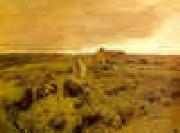 |
Jean Charles Cazin
|
|
1841-1901
French
Jean Charles Cazin Location
Painter and ceramicist. His earliest paintings reveal close affinities with the realist tradition, while his later compositions (mostly landscapes of northern France) demonstrate an awareness of Impressionism and a commitment to recording the changing effects of light and atmosphere. He was sent to England for health reasons but by 1862 or 1863 was living in Paris and active in avant-garde artistic circles. In 1863 he exhibited Recollections of the Dunes of Wissant (untraced), a work based on close observation of the coastline of northern France, at the Salon des Refuses. He enrolled at the Ecole Gratuite de Dessin under Horace Lecoq de Boisbaudran, where he became friends with Alphonse Legros, Thodule Ribot, Henri Fantin-Latour and Leon Lhermitte, all of whom adopted Boisbaudran method of developing paintings from memory as a way of heightening perceptions. During this period Cazin also met Marie Guillet, whom he married in 1868. |
|
|
|
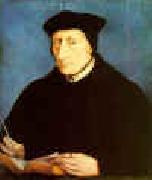 |
Jean Clouet
|
|
French Painter, ca.1485-1541
painter. He was chief painter to Francis I and produced many pastel portraits of members of the French court. Clouet was one of the best 16th-century portrait painters, both incisive and delicate in the psychological characterization of sitters. His drawings are simple, broad, and subtle; his paintings are fresh in colour, subdued in modeling, and minute in execution. He was celebrated in his lifetime as the equal of Michelangelo. His son Francois Clouet (c. 1515 ?C 72) took his place as official painter to Francis I in 1540. |
|
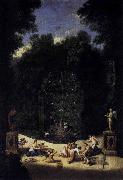 |
Jean Cotelle
|
|
Jean Cotelle
Jean Cotelle, 'the younger', was a painter and engraver, born in Paris in 1645. He received his early instruction from his father, Jean Cotelle, and eventually visited Italy. On his return he devoted himself to his profession, producing historical paintings, miniatures, and occasionally etchings. His chef-d'oeuvre was the 'Marriage at Cana,' painted in 1681 for the cathedral of Notre-Dame. There are by him at Versailles several views in the gardens of that palace. He etched a plate representing 'Our Lord on the Mount of Olives,' and a series of seven scenes from the history of Venus. He was admitted into the Academy in 1672, and died at Villers-sur-Marne in 1708. |
|
|
|
|
|
|
|
|
|
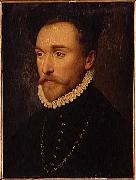 |
Jean Decourt
|
|
Jean de Court, an enamel painter of Limoges, succeeded François Clouet as painter to the king in 1572, and was in turn succeeded by his son, Charles de Court, in 1584 or 1589. Jean de Court painted in 1574 a portrait of Henry III, then Duke of Anjou. |
|
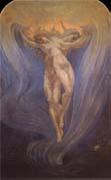 |
Jean Delville
|
|
Belgian Symbolist Painter, 1867-1953
Belgian painter, decorative artist and writer. He studied at the Academie Royale des Beaux-Arts, Brussels, with Jean-Franeois Portaels and the Belgian painter Joseph Stallaert (1825-1903). Among his fellow students were Eugene Laermans, Victor Rousseau and Victor Horta. From 1887 he exhibited at L Essor, where in 1888 Mother (untraced), which depicts a woman writhing in labour, caused a scandal. Although his drawings of the metallurgists working in the Cockerill factories near Charleroi were naturalistic, from 1887 he veered towards Symbolism: the drawing of Tristan and Isolde (1887; Brussels, Musees Royaux B.-A.), in its lyrical fusion of the two bodies, reveals the influence of Richard Wagner. Circle of the Passions (1889), inspired by Dante Alighieri Divina commedia, was burnt c. 1914; only drawings remain (Brussels, Musees Royaux B.-A.). Jef Lambeaux copied it for his relief Human Passions (1890-1900; Brussels, Parc Cinquantenaire). Delville became associated with Josephin Peladan, went to live in Paris and exhibited at the Salons de la Rose+Croix, created there by Peladan (1892-5). A devoted disciple of Peladan, he had his tragedies performed in Brussels and in 1895 painted his portrait (untraced). He exhibited Dead Orpheus (1893; Brussels, Gillion-Crowet priv. col.), an idealized head, floating on his lyre towards reincarnation, and Angel of Splendour (1894; Brussels, Gillion-Crowet priv. col.), a painting of great subtlety. |
|
|
|
 |
Jean Fouquet
|
|
French
1420-1479
Jean Fouquet Locations
French painter and illuminator. He is regarded as the most important French painter of the 15th century and was responsible for introducing Italian Renaissance elements into French painting. Little is known of his life, and, apart from a signed self-portrait medallion (Paris, Louvre), his only authenticated work is the Antiquit?s judaeques (Paris, Bib. N., MS. fr. 247). A corpus of works by Fouquet has therefore been established on the basis of stylistic criteria, but its exact chronology is uncertain. |
|
|
|
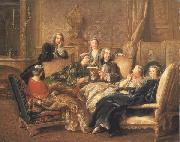 |
Jean Francois de troy
|
|
French Neoclassical Painter, 1679-1752
was a French Rococo painter and tapestry designer. He was one of a family of painters, being the son of the portrait painter François de Troy (1645-1730), under whom he first studied, and at whose expense he went to Italy 1699-1706, staying in Rome, but also visiting many north Italian cities. Jean François de Troy was born on January 27, 1679 in Paris. The successful career of Jean François de Troy was based initially on large historical and allegorical compositions, such as Time Unveiling Truth (1733) in the National Gallery, London, but he is now most highly regarded for his smaller and more spirited scenes of elegant social life. They are among the best of those that rode on the wave of Watteau's success indeed The Alarm, or the Gouvernante Fidele (Victoria and Albert Museum, London, 1723) was attributed to Watteau in the 19th century. A versatile artist, he made tableaux de modes famous, painting histories and mythologies in a colourful and fluent manner which owed something to both Veronese and Peter Paul Rubens. He undertook commissions for Versailles and Fontainebleau between 1724 and 1737, and designed two sets of tapestries for the Gobelins, each of seven subjects, the Histoire d'Esther (1737-40) and the Histoire de Jason (1743-6). |
|
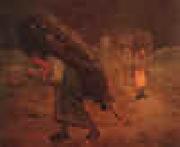 |
Jean Francois Millet
|
|
1814-1875
French
Jean Francois Millet Galleries
Millet was the first child of Jean-Louis-Nicolas and Aim??e-Henriette-Adelaide Henry Millet, members of the peasant community in the village of Gruchy, in Gr??ville-Hague (Normandy). Under the guidance of two village priests, Millet acquired a knowledge of Latin and modern authors, before being sent to Cherbourg in 1833 to study with a portrait painter named Paul Dumouchel. By 1835 he was studying full-time with Lucien-Th??ophile Langlois, a pupil of Baron Gros, in Cherbourg. A stipend provided by Langlois and others enabled Millet to move to Paris in 1837, where he studied at the Ecole des Beaux-Arts with Paul Delaroche. In 1839 his scholarship was terminated, and his first submission to the Salon was rejected.
After his first painting, a portrait, was accepted at the Salon of 1840, Millet returned to Cherbourg to begin a career as a portrait painter. However, the following year he married Pauline-Virginie Ono, and they moved to Paris. After rejections at the Salon of 1843 and Pauline's death by consumption, Millet returned again to Cherbourg. In 1845 Millet moved to Le Havre with Catherine Lemaire, whom he would marry in a civil ceremony in 1853; they would have nine children, and remain together for the rest of Millet's life. In Le Havre he painted portraits and small genre pieces for several months, before moving back to Paris.
It was in Paris in the middle 1840s that Millet befriended Constant Troyon, Narcisse Diaz, Charles Jacque, and Theodore Rousseau, artists who, like Millet, would become associated with the Barbizon school; Honor?? Daumier, whose figure draftsmanship would influence Millet's subsequent rendering of peasant subjects; and Alfred Sensier, a government bureaucrat who would become a lifelong supporter and eventually the artist's biographer. In 1847 his first Salon success came with the exhibition of a painting Oedipus Taken down from the Tree, and in 1848 his Winnower was bought by the government. |
|
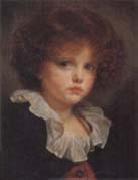 |
Jean Greuze
|
|
French 1725-1805
French painter and draughtsman. He was named an associate member of the Acad?mie Royale de Peinture et de Sculpture, Paris, in 1755 on the strength of a group of paintings that included genre scenes, portraits and studies of expressive heads (t?tes d'expression). These remained the essential subjects of his art for the next 50 years, except for a brief, concentrated and unsuccessful experiment with history painting in the late 1760s, which was to affect his later genre painting deeply. Though his art has often been compared with that of Jean-Sim?on Chardin in particular and interpreted within the context of NEO-CLASSICISM in general, it stands so strikingly apart from the currents of its time that Greuze's accomplishments are best described, as they often were by the artist's contemporaries, as unique. He was greatly admired by connoisseurs, critics and the general public throughout most of his life. His pictures were in the collections of such noted connoisseurs as Ange-Laurent de La Live de Jully, Claude-Henri Watelet and Etienne-Fran?ois, Duc de Choiseul. For a long period he was in particular favour with the critic Denis Diderot, who wrote about him in the Salon reviews that he published in Melchior Grimm's privately circulated Correspondance litt?raire. His reputation declined towards the end of his life and through the early part of the 19th century, to be revived after 1850, |
|
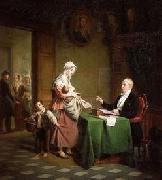 |
Jean Henri De Coene
|
|
Jean Henri De Coene, a Belgian painter of genre and historical subjects, was born at Nederbrakel in 1798. |
|
|

